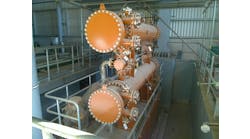"The Four Ds" received attention at the formal opening in late January of the Emerson Innovation Center — Process Systems and Solutions in Round Rock, Texas. That's because a key part of the facility is an "Integrated Operations Center" where customers can explore new ways to manage remote operations and enhance collaboration within the company and with outside experts.
[pullquote]
Right now, manufacturers face myriad difficulties in tackling the challenges posed by the Four Ds, notes Peter Zornio, chief strategic officer of Emerson Process Management. They must contend with worker shortages and loss of experienced personnel in general — but finding suitable people willing to go to remote, inhospitable locations is an even tougher task. In addition, the companies suffer from disconnections among job functions and disjointed communication and decision-making.
So, firms are turning to a new organizational model called integrated operations to confront the challenges, he explains. This usually involves putting people from key functional groups such as operations, maintenance, business planning and logistics at a single convenient and hospitable location. Creating an environment with specialized applications and teleconferencing to enhance access to field staff as well as to internal and outside experts can play a key role in spurring dynamic collaboration. Another must is providing actionable real-time data including for business analysis. The aim is to streamline decision-making and align organizational priorities and metrics.
The building blocks for integrated operations include reliable, secure, high-bandwidth connections, wireless sensors and mobile worker infrastructure, and collaboration tools, Zornio stresses. Highly flexible, scalable automation and safety systems, as well as coordination of local and remote control, also are essential. So, too, is full integration of systems from enterprise resource planning on down, and the availability of accurate, real-time production, equipment-health, safety, environmental, logistics, business and other data, he adds.
To help its customers succeed with integrated operations, — or iOps to use Emerson's term — the Round Rock facility includes a 14,000-ft2 iOps Center. "We worked for nearly two years on the vision and execution of the iOps Center," says Jim Nyquist, president of Process Systems and Solutions for Emerson Process Management. "Customers gain a clear vision of what's possible through an experience they can't get anywhere else in the world."
Its centerpiece is the iOps Command Center. In this state-of-the-art room, personnel can monitor remote operations (as well as an on-site skid with mixing and separation units), check the performance and health of assets worldwide, conduct videoconferences with field staff and specialists, and make decisions to optimize process and business results. The Command Center features a 30-ft × 6-ft. video wall that shows operators' level 1 overview displays, closed-circuit video feeds, dashboards of key performance indicators, and other visuals. The idea, says Emerson, is to give customers a realistic look at technologies and work processes they might consider.
Besides the Integrated Operations Center, the new 282,000-ft2, almost-$70-million facility houses Emerson's Human Centered Design Institute, which focuses on making products easier to use, an interoperability and testing lab for checking the company's and competitors' products, a training facility for customers, as well as other operations. It also serves as global headquarters for Emerson's automation systems and project services businesses.
The innovation center joins Emerson's existing ones on flow control applications and technologies at Marshalltown, Iowa (see: "Marshalltown Really Builds Upon a Legacy") and software application development at Pune, India.
Be sure to check out his Google+ page.



